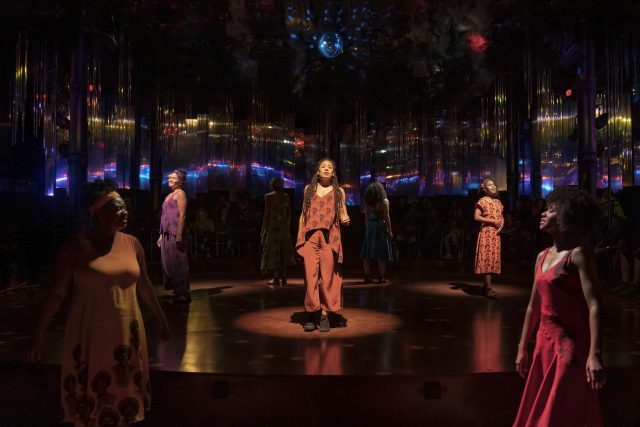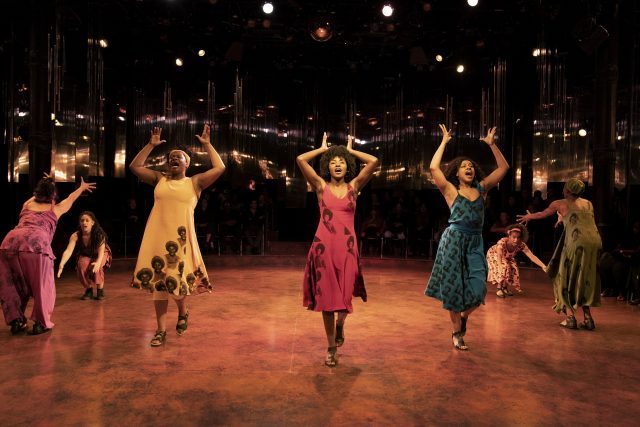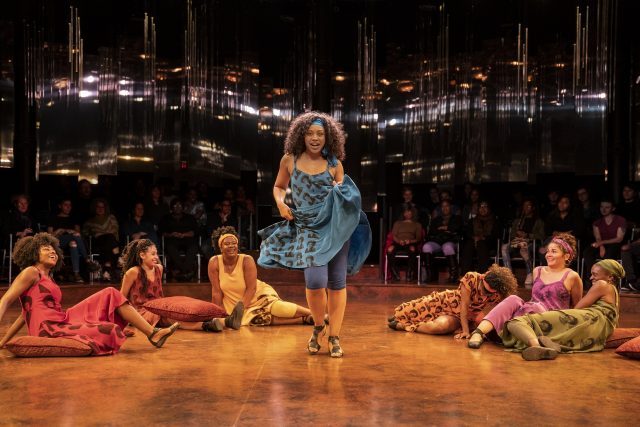
Lady in Brown (Celia Chevalier) stands center stage in exhilarating revival of for colored girls who have considered suicide / when the rainbow is enuf at the Public (photo by Joan Marcus)
Martinson Hall, the Public Theater
425 Lafayette St. at Astor Pl.
Tuesday through Sunday through December 15, $85-$150
212-539-8500
publictheater.org
I remember as a kid being intrigued by a television commercial for an oddly named play — for colored girls who have considered suicide / when the rainbow is enuf. I even recall the precise, rhythmic elocution used by the female announcer pronouncing the title, which included a word I didn’t think you could say anymore on television. I was further fascinated when my parents came home from the show at the Booth and gave me the Playbill, which listed a cast of seven women by color (Lady in Brown, Lady in Yellow, etc.), with Lady in Orange portrayed by the playwright herself, Ntozake Shange. More than forty years later, I finally understand what the hubbub was all about after seeing Leah C. Gardiner’s stirring revival at the Public Theater, where the original production moved in 1976 after earlier iterations at smaller venues in Berkeley and downtown New York (and shortly before moving to Broadway).

Seven women come together to share their stories and empower one another in Ntozake Shange’s brilliant choreopoem (photo by Joan Marcus)
Extended at the Public’s Martinson Theater through December 15, for colored girls is a breathtaking “choreopoem” with music, performed by seven women named for the colors of the rainbow, with the addition of one: Lady in Red (Jayme Lawson), Lady in Orange (Danaya Esperanza), Lady in Yellow (Adrienne C. Moore), Lady in Green (Okwui Okpokwasili), Lady in Blue (Sasha Allen), Lady in Purple (Alexandria Wailes), and Lady in Brown (Celia Chevalier). Over the course of ninety thrilling minutes, each actress takes center stage, sharing stories about the “dark phrases of womanhood,” including sex, racism, misogyny, gender bias, slavery, domestic violence, abortion, and rape. But these women refuse to view themselves as victims or even survivors. They each wear outfits that feature the face of their most beloved female relative (the dazzling costumes are by Toni-Leslie James), and they have taken their power back, controlling their personal narrative and identity as they openly support one another in an invigorating display of camaraderie and friendship through both good and bad times. Often the ensemble forms a semicircle of love and respect as they watch each other deliver their tales in turn. They are seven unique personalities with unique body types moving individually and in unison to choreography by Tony nominee Camille A. Brown and original music by Martha Redbone in addition to such familiar songs as Martha and the Vandellas’ “Dancing in the Streets” and the Dells’ “Stay in My Corner.”
They hail from Nashville, Washington DC, Strasbourg, Harlem, Havana, Brooklyn, and Delaware but are from anywhere and everywhere. “Are we ghouls? / children of horror?/ the joke? / don’t tell nobody don’t tell a soul / are we animals? have we gone crazy?” Lady in Brown asks, adding, “This is for colored girls who have considered suicide / but moved to the ends of their own rainbows.” But as exhilarating and potent as it all is, the women understand the reality of their daily existence. “We gotta dance to keep from cryin,” Lady in Yellow says. “We gotta dance to keep from dyin,” Lady in Brown adds. “I come in at dusk / stay close to the curb / round midnite / praying wont no young man / think i’m pretty in a dark morning,” Lady in Blue admits.

Sasha Allen brings down the house as Lady in Blue in for colored girls revival (photo by Joan Marcus)
The cast is fantastic, highlighted by Allen (Hair, Ghetto Superstar) tearing down the house with a rousing number about satisfaction and an intimate solo dance by Okpokwasili (Poor People’s TV Room, Bronx Gothic), while Moore (Orange Is the New Black, The Taming of the Shrew) brings an infectious, unbridled enthusiasm to her role. Myung Hee Cho’s inclusive set features three rows of chairs along the back arch of the circular stage, in front of a large mirror, which reflects the audience so they appear right behind the cast, who enter and exit through three different doorways. Jiyoun Chang’s lighting is often very bright, so everyone in the theater is usually visible.
Obie winner Gardiner (If Pretty Hurts Ugly Must Be a Muhfucka, born bad) and her all-female crew have crafted an emotionally involving and stimulating work, anchored by Obie-winning, Oscar-nominated poet, novelist, playwright, kids’ book author, activist, and essayist Shange’s (Mother Courage and Her Children, Whitewash) gorgeous words, which resonate with truth and beauty; it’s a shame that the Trenton-born Shange did not get to see this triumphant revival of her play (which she updated in 2010 and was inspired by her own life, which included four suicide attempts), as she passed away last year at the age of seventy, leaving behind a wide-ranging and deeply powerful legacy.